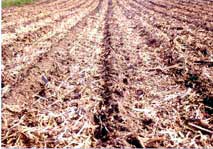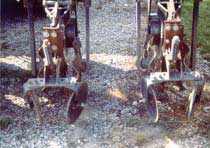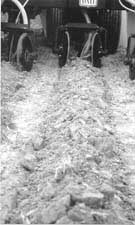
Tillage
in Long Straight Lines
Doing fall tillage but confining it to narrow zones which correspond to next year's corn rows is an idea that has received considerable attention over the past few years. At the Outdoor Farm Show in Ontario, as well as the Farm Progress Show in Indiana this year, it was attracting a lot of attention and producing many new pieces of equipment.
The fact that no-till corn acres have declined in the Eastern Corn Belt in the past few years has spurred on interest in strip tillage in both the public and private sectors.
The idea is to prepare strips of soil that are loosened, cleared of residue and hopefully somewhat elevated while leaving the rest of the field covered and protected by residue. In turn, these strips are drier, less dense and more suited to single pass corn planting in the spring.
Research at the University of Guelph over the period 1994-1996 employed a Trans-till (distributed by Becker Farm Equipment Ltd., Exeter) to do strip tillage in the fall in winter wheat stubble. Table 1 points out that on these fine textured soils, strip tillage in the fall produced yields that were generally superior to no-till and in some instances equal to the conventional moldboard system.
Soil Conditions at Planting
Cool wet spring weather has been the driving force behind strip tillage expansion in the Northeastern Corn Belt. In-row areas that are loosened and ridged in the fall are reported being up to four degrees warmer in the spring than no-till fields, which helped planting. Soil moisture levels measured on the University of Guelph plots indicate soils in the strip-tilled zone were consistently drier in early May than in the undisturbed no-till plots (see Table 1). Although yield responses in side-by-side trials may not always indicate a benefit to strip tillage, corn producers in Ontario with large acreage, poorly draining soils, or high surface residues may gain a consistent benefit from strip tillage in terms of planting timeliness, emergence and early corn growth.
| Table 1 | |||
|---|---|---|---|
| Strip
tillage for corn after winter wheat (baled straw) (1994-96) T.J. Vyn, 1997, University of Guelph |
|||
|
|
|
|
|
|
|
|
||
| Fall moldboard |
|
|
|
| Fall chisel |
|
|
|
| Fall disc |
|
|
|
| Fall strip-till |
|
|
|
| No-till |
|
|
|
| *Note - Moldboard and chisel plowed plots were cultivated and packed in spring. Fall disc and strip-till plots were simply no-till planted in spring. Strip-till plots used a Trans-till operating at 15-18 cm deep. All treatments planted the same day. | |||
Fertilizer Placement
Combining fertilizer placement at a depth of four to six inches, while fall strip tilling, is an approach being promoted actively in some areas and by certain equipment manufacturers. In fact, some strip tillage units consist of nothing more than anhydrous ammonia applicators with closing discs so that nitrogen is knifed in, and a ridge is formed in the fall to await next spring's corn planter. Ontario conditions are more suited to banding P and K, rather than nitrogen, during the fall strip tillage operation. Equipment is available which is designed specifically to carry and deliver dry fertilizer while performing fall strip tillage. I believe producers who own or are contemplating the purchase of an air seeding system should give some consideration to using this device for delivering fertilizer to their strip tillage tool bar.

|

|

|
| Figure 1: Strip tillage completed on soybean ground. | Figure 2: Trans-till unit modified with Yetter closing disks for improving the mound formation in the fall. (Courtesy Dick Buitenbuis, Ridgetown) | Figure 3: DMI unit for strip tillage and dry fertilizer placement in one pass. |
Depth of Tillage
If a strip tilled to a depth of six or seven inches is good, then is going twice that deep better? Probably not. There's little evidence to support deep strip tillage for corn. Currently the OCPA is supporting a CanAdapt funded project, where University of Guelph and Agriculture and Agri-Food Canada researchers are examining the effect of strip tillage depth on corn productivity. This year was the first of the three-year study and results will be made available as soon as possible. If you have conditions where you feel deep loosening is imperative, doing it in confined zones for the corn row might make some sense. This is especially true if you are willing to impose a controlled traffic system on your fields to avoid driving over those deep tilled zones. A significant amount of tillage research across the world would indicate that high axle loads compact previously sub-soiled fields to conditions that are as dense or perhaps even more dense than they were originally, and require ongoing deep tillage to maintain yields. Controlling traffic can be a challenge, but if you adopted a strip tillage system for corn and planted your soybeans in twin rows on top of that zone, it would keep traffic from reconsolidating the strips throughout a large percentage of your cropping cycle.
Summary
In assessing the strip tillage system consider the following:
Soil conditions at planting may well be superior to no-till especially on heavy soils or in high residue situations, and your planting window will widen.
1) Keep the strip mounded about two to four inches; you don't want to throw soil out into the inter-row area or plant into a depression.
2) Consider applying P and K while performing fall strip tillage as part of a system to capture further gains in spring corn planting productivity.
3) On rolling topography take care not to cut grooves that will be predisposed to soil erosion.
4) If at all possible keep wheel traffic off strip-tilled zones, especially if you have gone to the time and expense to do deep tillage.
Back to Top